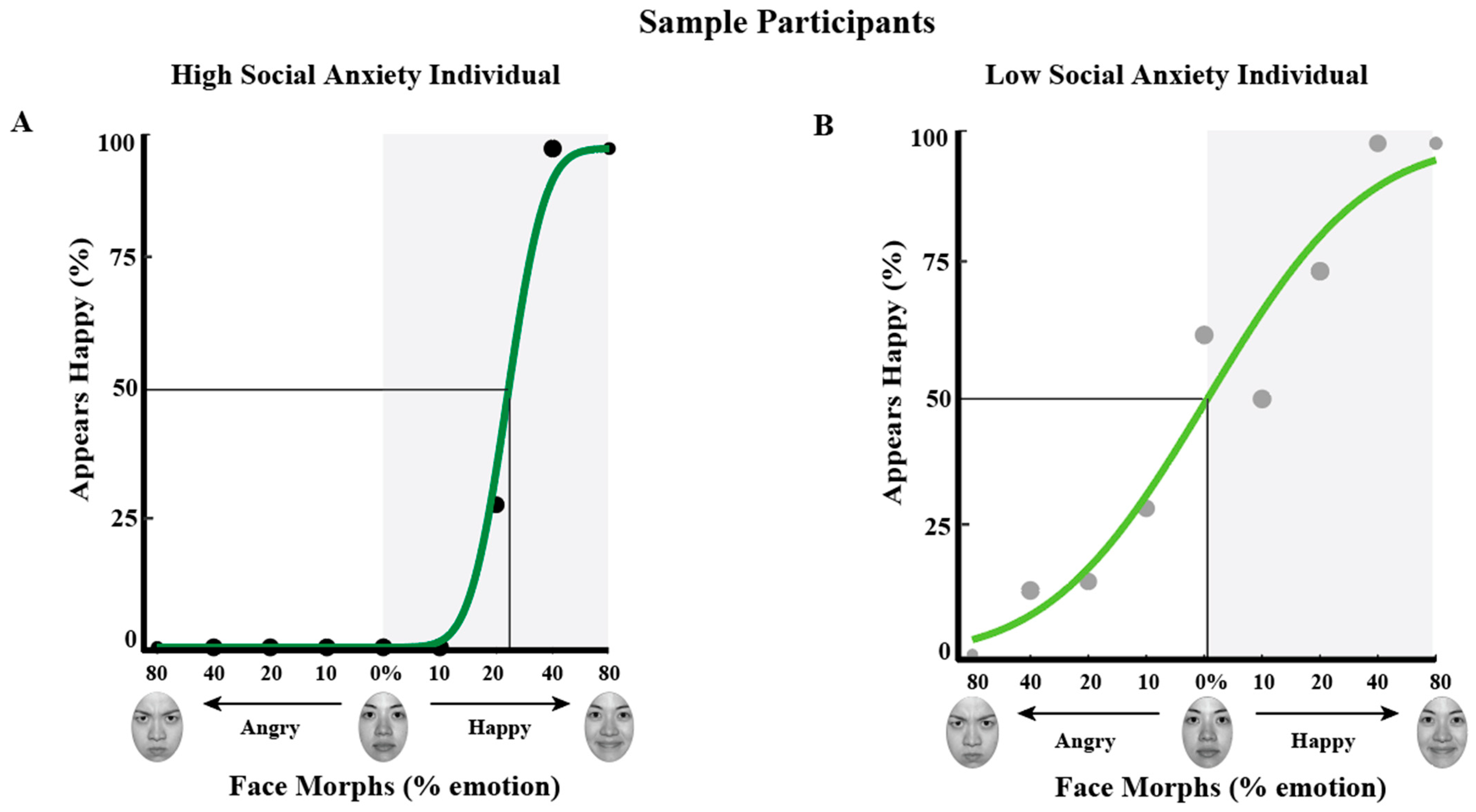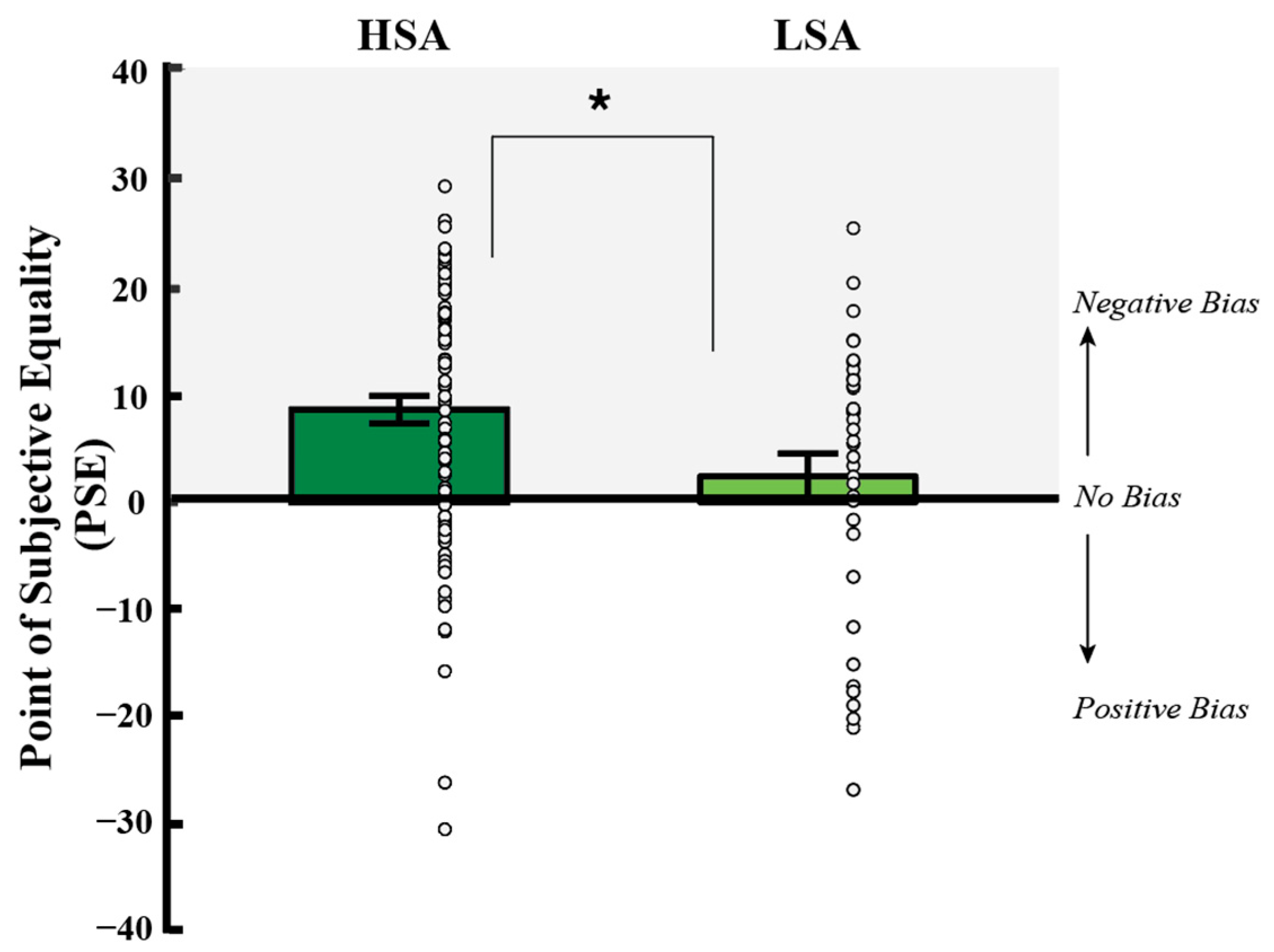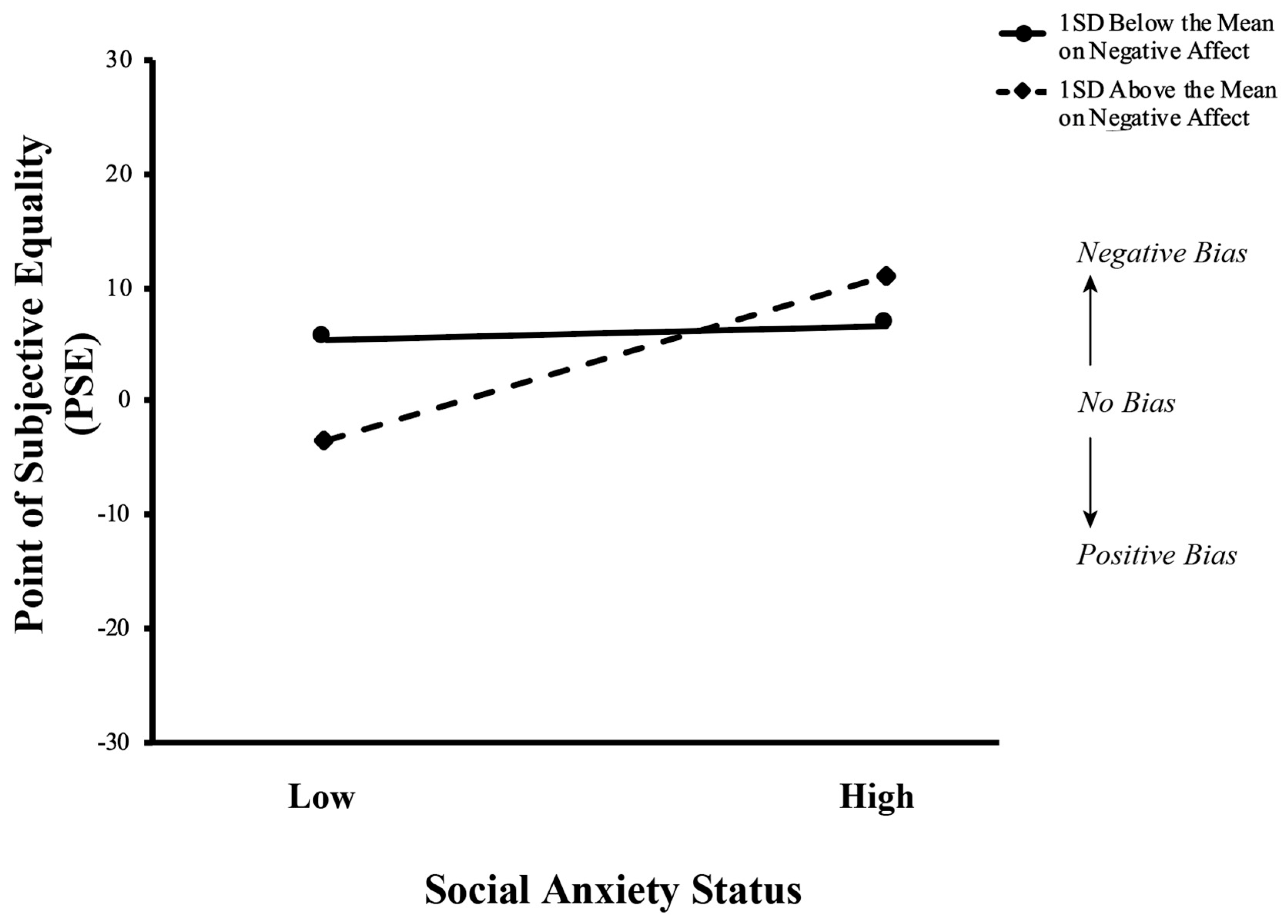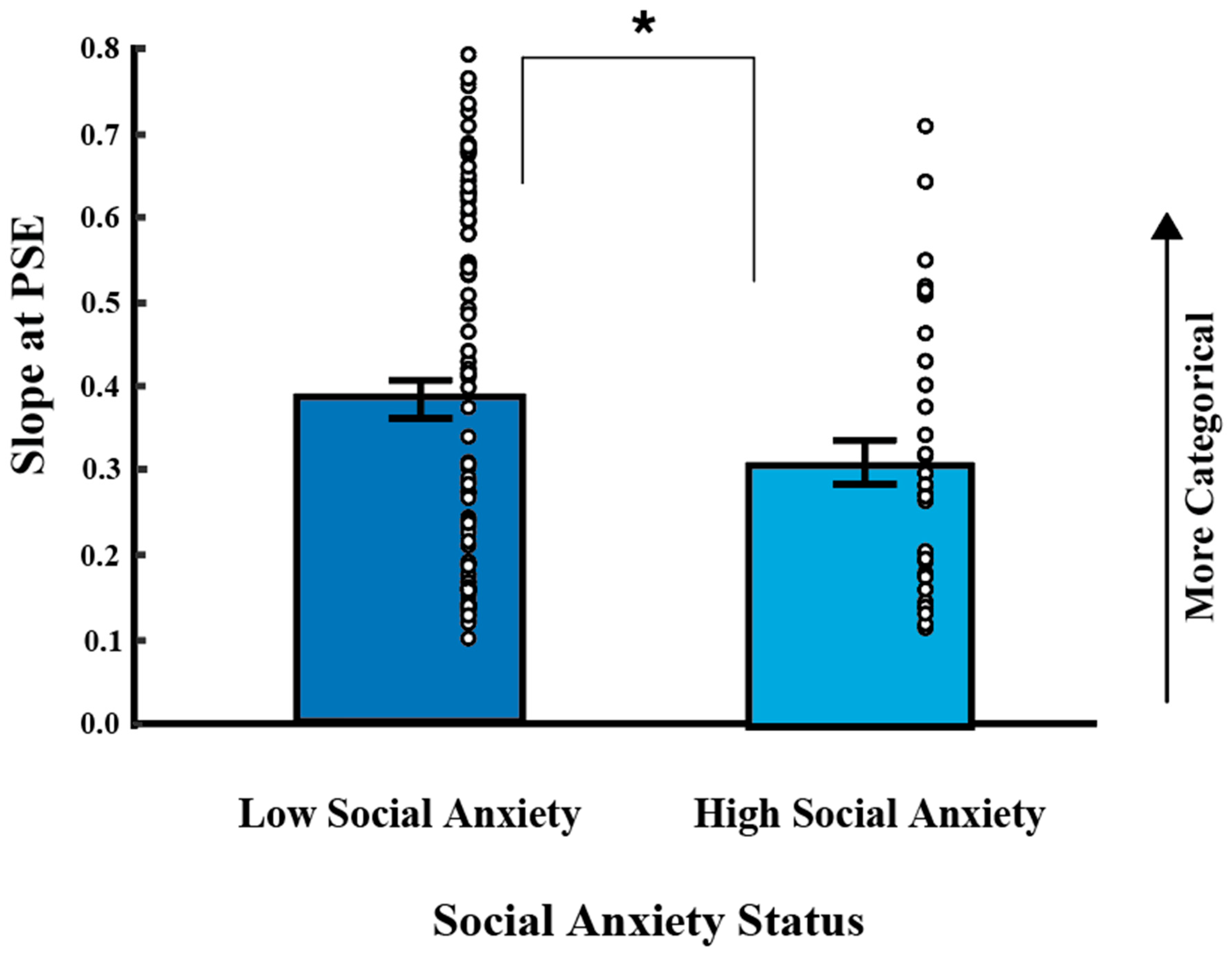Biases in Perceiving Positive Versus Negative Emotions: The Influence of Social Anxiety and State Affect
Abstract
1. Introduction
1.1. Biases in Social Anxiety
- In terms of perceptual biases, social anxiety has been characterized by a tendency to perceive emotional expressions as more negative. Socially anxious individuals also have elevated sensitivity to negative expressions of emotion, demonstrating lower thresholds for identifying and detecting faces conveying anger and disgust, e.g., [19,20]. Individuals high in social anxiety show more frequent detection of angry facial expressions [21], enhanced recognition of negative facial expressions relative to positive expressions [22], and tend to rate negative facial expressions more negatively compared to individuals low in social anxiety [23,24].
1.2. Influence of Trait vs. State Affect
1.3. The Current Study
Transparency and Openness
2. Materials and Methods
2.1. Participants
2.2. Measures
2.3. Determining Perceptual Biases
2.3.1. Apparatus
2.3.2. Stimuli
2.3.3. Procedures
2.4. Data Analysis
2.4.1. Quantifying Biases in the Perception of Emotional Faces
2.4.2. Statistical Analyses
3. Results
3.1. Perceptual Bias, as Assessed by the PSE
3.2. The Influence of Social Anxiety and Negative Affect on PSE
3.3. Interaction Between Social Anxiety Status and Negative Affect on PSE
3.4. The Influence of Social Anxiety and Negative Affect on Slope
4. Discussion
4.1. Biases in Negative Affect and Biases in Perception
4.2. Considerations of State Affect Versus Trait Anxiety
4.3. Limitations
4.4. Theoretical Implications
4.5. Practical Implications
5. Conclusions
Author Contributions
Funding
Institutional Review Board Statement
Informed Consent Statement
Data Availability Statement
Acknowledgments
Conflicts of Interest
Abbreviations
| PSE | point of subjective equality |
| LSA | low in social anxiety |
| HSA | high in social anxiety |
| BFNE | Brief Fear of Negative Evaluation |
| DASS | Depression Anxiety Stress Scales |
| PANAS | Positive and Negative Affect Schedule |
| PA | positive affect |
| NA | negative affect |
References
- Levin, D.T. Classifying faces by race: The structure of face categories. J. Exp. Psychol. Learn. Mem. Cogn. 1996, 22, 1364–1382. [Google Scholar] [CrossRef]
- Yamaguchi, M.K.; Hirukawa, T.; Kanazawa, S. Judgment of Gender through Facial Parts. Perception 2013, 42, 1253–1265. [Google Scholar] [CrossRef] [PubMed]
- Öhman, A.; Flykt, A.; Esteves, F. Emotion drives attention: Detecting the snake in the grass. J. Exp. Psychol. Gen. 2001, 130, 466–478. [Google Scholar] [CrossRef]
- Kessler, R.C.; Petukhova, M.; Sampson, N.A.; Zaslavsky, A.M.; Wittchen, H.U. Twelve-month and lifetime prevalence and lifetime morbid risk of anxiety and mood disorders in the United States. Int. J. Methods Psychiatr. Res. 2012, 21, 169–184. [Google Scholar] [CrossRef]
- American Psychiatric Association. Diagnostic and Statistical Manual of Mental Disorders, 5th ed.; Text Revision; American Psychiatric Association: Washington, DC, USA, 2022. [Google Scholar]
- Öhman, A. Face the Beast and Fear the Face: Animal and Social Fears as Prototypes for Evolutionary Analyses of Emotion. Psychophysiology 1986, 23, 123–145. [Google Scholar] [CrossRef]
- Trower, P.; Gilbert, P. New theoretical conceptions of social anxiety and social phobia. Clin. Psychol. Rev. 1989, 9, 19–35. [Google Scholar] [CrossRef]
- Clark, D.M.; Wells, A. A cognitive model of social phobia. Soc. Phobia Diagn. Assess. Treat. 1995; 41, 00022–00023. [Google Scholar]
- Rapee, R.M.; Heimberg, R.G. A cognitive-behavioral model of anxiety in social phobia. Behav. Res. Ther. 1997, 35, 741–756. [Google Scholar] [CrossRef]
- Heinrichs, N.; Hofmann, S.G. Information processing in social phobia: A critical review. Clin. Psychol. Rev. 2001, 21, 751–770. [Google Scholar] [CrossRef]
- Hofmann, S.G. Cognitive Factors that Maintain Social Anxiety Disorder: A Comprehensive Model and its Treatment Implications. Cogn. Behav. Ther. 2007, 36, 193–209. [Google Scholar] [CrossRef] [PubMed]
- Bar-Haim, Y.; Lamy, D.; Pergamin, L.; Bakermans-Kranenburg, M.J.; van IJzendoorn, M.H. Threat-related attentional bias in anxious and nonanxious individuals: A meta-analytic study. Psychol. Bull. 2007, 133, 1–24. [Google Scholar] [CrossRef] [PubMed]
- Mogg, K.; Bradley, B.P. Selective orienting of attention to masked threat faces in social anxiety. Behav. Res. Ther. 2002, 40, 1403–1414. [Google Scholar] [CrossRef]
- Wang, Y.; Liang, J.; Zhu, Z.; Gao, J.; Yao, Q.; Ding, X. Attentional Bias of Individuals with Social Anxiety towards Facial and Somatic Emotional Cues in a Holistic Manner. Behav. Sci. 2024, 14, 244. [Google Scholar] [CrossRef]
- Taylor, C.T.; Bomyea, J.; Amir, N. Attentional bias away from positive social information mediates the link between social anxiety and anxiety vulnerability to a social stressor. J. Anxiety Disord. 2010, 24, 403–408. [Google Scholar] [CrossRef] [PubMed]
- Horley, K.; Williams, L.M.; Gonsalvez, C.; Gordon, E. Face to face: Visual scanpath evidence for abnormal processing of facial expressions in social phobia. Psychiatry Res. 2004, 127, 43–53. [Google Scholar] [CrossRef] [PubMed]
- Amir, N.; Foa, E.B.; Coles, M.E. Automatic activation and strategic avoidance of threat-relevant information in social phobia. J. Abnorm. Psychol. 1998, 107, 285. [Google Scholar] [CrossRef]
- Barbot, A.; Carrasco, M. Emotion and anxiety potentiate the way attention alters visual appearance. Sci. Rep. 2018, 8, 5938. [Google Scholar] [CrossRef]
- Gutiérrez-García, A.; Calvo, M.G. Social anxiety and threat-related interpretation of dynamic facial expressions: Sensitivity and response bias. Personal. Individ. Differ. 2017, 107, 10–16. [Google Scholar] [CrossRef]
- Joormann, J.; Gotlib, I.H. Is this happiness I see? Biases in the identification of emotional facial expressions in depression and social phobia. J. Abnorm. Psychol. 2006, 115, 705. [Google Scholar] [CrossRef] [PubMed]
- Gilboa-Schechtman, E.; Foa, E.B.; Amir, N. Attentional biases for facial expressions in social phobia: The face-in-the-crowd paradigm. Cogn. Emot. 1999, 13, 305–318. [Google Scholar] [CrossRef]
- Foa, E.B.; Gilboa-Schechtman, E.; Amir, N.; Freshman, M. Memory Bias in Generalized Social Phobia: Remembering Negative Emotional Expressions. J. Anxiety Disord. 2000, 14, 501–519. [Google Scholar] [CrossRef]
- Dimberg, U.; Thunberg, M. Speech anxiety and rapid emotional reactions to angry and happy facial expressions. Scand. J. Psychol. 2007, 48, 321–328. [Google Scholar] [CrossRef]
- Schofield, C.A.; Coles, M.E.; Gibb, B.E. Social anxiety and interpretation biases for facial displays of emotion: Emotion detection and ratings of social cost. Behav. Res. Ther. 2007, 45, 2950–2963. [Google Scholar] [CrossRef]
- Mobini, S.; Reynolds, S.; Mackintosh, B. Clinical implications of cognitive bias modification for interpretative biases in social anxiety: An integrative literature review. Cogn. Ther. Res. 2013, 37, 173–182. [Google Scholar] [CrossRef]
- Bell, C.; Bourke, C.; Colhoun, H.; Carter, F.; Frampton, C.; Porter, R. The misclassification of facial expressions in generalised social phobia. J. Anxiety Disord. 2011, 25, 278–283. [Google Scholar] [CrossRef]
- Yoon, K.L.; Zinbarg, R.E. Threat is in the eye of the beholder: Social anxiety and the interpretation of ambiguous facial expressions. Behav. Res. Ther. 2007, 45, 839–847. [Google Scholar] [CrossRef] [PubMed]
- Mohlman, J.; Carmin, C.N.; Price, R.B. Jumping to interpretations: Social anxiety disorder and the identification of emotional facial expressions. Behav. Res. Ther. 2007, 45, 591–599. [Google Scholar] [CrossRef]
- Amir, N.; Prouvost, C.; Kuckertz, J.M. Lack of a benign interpretation bias in social anxiety disorder. Cogn. Behav. Ther. 2012, 41, 119–129. [Google Scholar] [CrossRef] [PubMed]
- Beard, C.; Amir, N. Interpretation in Social Anxiety: When Meaning Precedes Ambiguity. Cogn. Ther. Res. 2009, 33, 406–415. [Google Scholar] [CrossRef] [PubMed]
- Frenkel, T.I.; Bar-Haim, Y. Neural activation during the processing of ambiguous fearful facial expressions: An ERP study in anxious and nonanxious individuals. Biol. Psychol. 2011, 88, 188–195. [Google Scholar] [CrossRef]
- Rossignol, M.; Anselme, C.; Vermeulen, N.; Philippot, P.; Campanella, S. Categorical perception of anger and disgust facial expression is affected by non-clinical social anxiety: An ERP study. Brain Res. 2007, 1132, 166–176. [Google Scholar] [CrossRef]
- Button, K.; Lewis, G.; Penton-Voak, I.; Munafò, M. Social anxiety is associated with general but not specific biases in emotion recognition. Psychiatry Res. 2013, 210, 199–207. [Google Scholar] [CrossRef] [PubMed]
- Jusyte, A.; Schönenberg, M. Threat processing in generalized social phobia: An investigation of interpretation biases in ambiguous facial affect. Psychiatry Res. 2014, 217, 100–106. [Google Scholar] [CrossRef]
- Riepl, K.; Mussel, P.; Osinsky, R.; Hewig, J. Influences of State and Trait Affect on Behavior, Feedback-Related Negativity, and P3b in the Ultimatum Game. PLoS ONE 2016, 11, e0146358. [Google Scholar] [CrossRef] [PubMed]
- Mathews, A.; Mackintosh, B. A Cognitive Model of Selective Processing in Anxiety. Cogn. Ther. Res. 1998, 22, 539–560. [Google Scholar] [CrossRef]
- Leber, S.; Heidenreich, T.; Stangier, U.; Hofmann, S.G. Processing of facial affect under social threat in socially anxious adults: Mood matters. Depress. Anxiety 2009, 26, 196–206. [Google Scholar] [CrossRef]
- Quigley, L.; Nelson, A.L.; Carriere, J.; Smilek, D.; Purdon, C. The effects of trait and state anxiety on attention to emotional images: An eye-tracking study. Cogn. Emot. 2012, 26, 1390–1411. [Google Scholar] [CrossRef]
- Cooper, R.M.; Langton, S.R.H. Attentional bias to angry faces using the dot-probe task? It depends when you look for it. Behav. Res. Ther. 2006, 44, 1321–1329. [Google Scholar] [CrossRef]
- Usala, P.D.; Hertzog, C. Evidence of differential stability of state and trait anxiety in adults. J. Personal. Soc. Psychol. 1991, 60, 471–479. [Google Scholar] [CrossRef]
- Saviola, F.; Pappaianni, E.; Monti, A.; Grecucci, A.; Jovicich, J.; De Pisapia, N. Trait and state anxiety are mapped differently in the human brain. Sci. Rep. 2020, 10, 11112. [Google Scholar] [CrossRef]
- Kuppens, P.; Van Mechelen, I.; Nezlek, J.B.; Dossche, D.; Timmermans, T. Individual differences in core affect variability and their relationship to personality and psychological adjustment. Emotion 2007, 7, 262–274. [Google Scholar] [CrossRef]
- Mogg, K.; Bradley, B.P.; Miles, F.; Dixon, R. Time course of attentional bias for threat scenes: Testing the vigilance-avoidance hypothesis. Cogn. Emot. 2004, 18, 689–700. [Google Scholar] [CrossRef]
- Gard, K.A.; Gard, G.C.; Dossett, D.; Turone, R. Accuracy in Nonverbal Communication as Affected by Trait and State Anxiety. Percept. Mot. Ski. 1982, 55, 747–753. [Google Scholar] [CrossRef]
- Roelofs, K.; van Peer, J.; Berretty, E.; de Jong, P.; Spinhoven, P.; Elzinga, B.M. Hypothalamus–Pituitary–Adrenal Axis Hyperresponsiveness Is Associated with Increased Social Avoidance Behavior in Social Phobia. Biol. Psychiatry 2009, 65, 336–343. [Google Scholar] [CrossRef]
- Calvo, M.G.; Castillo, M.D. Mood congruent Bias in Interpretation of Ambiguity Strategic Processes and Temporary Activation. Q. J. Exp. Psychol. Sect. A 1997, 50, 163–182. [Google Scholar] [CrossRef]
- MacLeod, C.; Rutherford, E.M. Anxiety and the selective processing of emotional information: Mediating roles of awareness, trait and state variables, and personal relevance of stimulus. Behav. Res. Ther. 1992, 30, 479–491. [Google Scholar] [CrossRef]
- Mullins, D.; Duke, M.P. Effects of Social Anxiety on Nonverbal Accuracy and Response Time I: Facial Expressions. J. Nonverbal Behav. 2004, 28, 3–33. [Google Scholar] [CrossRef]
- Williams, J.M.G.; Watts, F.N.; MacLeod, C.; Mathews, A. Cognitive Psychology and Emotional Disorders; John Wiley & Sons: Hoboken, NJ, USA, 1988. [Google Scholar]
- Harris, D.A.; Hayes-Skelton, S.A.; Ciaramitaro, V.M. What’s in a Face? How Face Gender and Current Affect Influence Perceived Emotion. Front. Psychol. 2016, 7, 1468. [Google Scholar] [CrossRef]
- Jackson, M.C.; Arlegui-Prieto, M. Variation in normal mood state influences sensitivity to dynamic changes in emotional expression. Emotion 2016, 16, 145–149. [Google Scholar] [CrossRef] [PubMed]
- Mekawi, Y.; Murphy, L.; Munoz, A.; Briscione, M.; Tone, E.B.; Norrholm, S.D.; Jovanovic, T.; Bradley, B.; Powers, A. The role of negative affect in the association between attention bias to threat and posttraumatic stress: An eye-tracking study. Psychiatry Res. 2020, 284, 112674. [Google Scholar] [CrossRef]
- Fernández-Álvarez, J.; Colombo, D.; Gómez Penedo, J.M.; Pierantonelli, M.; Baños, R.M.; Botella, C. Studies of Social Anxiety Using Ambulatory Assessment: Systematic Review. JMIR Ment. Health 2024, 11, e46593. [Google Scholar] [CrossRef]
- Doorley, J.D.; Goodman, F.R.; Disabato, D.J.; Kashdan, T.B.; Weinstein, J.S.; Shackman, A.J. The momentary benefits of positive events for individuals with elevated social anxiety. Emotion 2021, 21, 595–606. [Google Scholar] [CrossRef]
- Webster, M.A.; Kaping, D.; Mizokami, Y.; Duhamel, P. Adaptation to natural facial categories. Nature 2004, 428, 557–561. [Google Scholar] [CrossRef] [PubMed]
- Koyuncu, A.; İnce, E.; Ertekin, E.; Tükel, R. Comorbidity in social anxiety disorder: Diagnostic and therapeutic challenges. Drugs Context 2019, 8, 212573. [Google Scholar] [CrossRef]
- Watson, D.; Clark, L.A.; Carey, G. Positive and negative affectivity and their relation to anxiety and depressive disorders. J. Abnorm. Psychol. 1988, 97, 346. [Google Scholar] [CrossRef]
- Morina, E.; Harris, D.A.; Hayes-Skelton, S.A.; Ciaramitaro, V.M. Altered mechanisms of adaptation in social anxiety: Differences in adapting to positive versus negative emotional faces. Cogn. Emot. 2024, 38, 727–747. [Google Scholar] [CrossRef]
- Leary, M.R. A brief version of the Fear of Negative Evaluation Scale. Personal. Soc. Psychol. Bull. 1983, 9, 371–375. [Google Scholar] [CrossRef]
- Rodebaugh, T.L.; Woods, C.M.; Thissen, D.M.; Heimberg, R.G.; Chambless, D.L.; Rapee, R.M. More Information from Fewer Questions: The Factor Structure and Item Properties of the Original and Brief Fear of Negative Evaluation Scale. Psychol. Assess. 2004, 16, 169–181. [Google Scholar] [CrossRef] [PubMed]
- Carleton, R.N.; Collimore, K.C.; McCabe, R.E.; Antony, M.M. Addressing revisions to the Brief Fear of Negative Evaluation scale: Measuring fear of negative evaluation across anxiety and mood disorders. J. Anxiety Disord. 2011, 25, 822–828. [Google Scholar] [CrossRef] [PubMed]
- Weeks, J.W.; Heimberg, R.G.; Rodebaugh, T.L.; Goldin, P.R.; Gross, J.J. Psychometric evaluation of the Fear of Positive Evaluation Scale in patients with social anxiety disorder. Psychol. Assess. 2012, 24, 301. [Google Scholar] [CrossRef]
- Lovibond, P.F.; Lovibond, S.H. The structure of negative emotional states: Comparison of the Depression Anxiety Stress Scales (DASS) with the Beck Depression and Anxiety Inventories. Behav. Res. Ther. 1995, 33, 335–343. [Google Scholar] [CrossRef]
- Antony, M.M.; Bieling, P.J.; Cox, B.J.; Enns, M.W.; Swinson, R.P. Psychometric properties of the 42-item and 21-item versions of the Depression Anxiety Stress Scales in clinical groups and a community sample. Psychol. Assess. 1998, 10, 176. [Google Scholar] [CrossRef]
- Langer, J.K.; Rodebaugh, T.L. Comorbidity of social anxiety disorder and depression. In The Oxford Handbook of Depression and Comorbidity; Oxford University Press: Oxford, UK, 2014; pp. 111–128. [Google Scholar] [CrossRef]
- Watson, D.; Clark, L.A.; Tellegen, A. Development and validation of brief measures of positive and negative affect: The PANAS scales. J. Personal. Soc. Psychol. 1988, 54, 1063. [Google Scholar] [CrossRef]
- Brainard, D.H. The psychophysics toolbox. Spat. Vis. 1997, 10, 433–436. [Google Scholar] [CrossRef]
- Kleiner, M.; Brainard, D.; Pelli, D. What’s New in Psychtoolbox-3? MPG: Munich, Germany, 2007. [Google Scholar]
- Pelli, D.G. The VideoToolbox software for visual psychophysics: Transforming numbers into movies. Spat. Vis. 1997, 10, 437–442. [Google Scholar] [CrossRef]
- Tottenham, N.; Tanaka, J.W.; Leon, A.C.; McCarry, T.; Nurse, M.; Hare, T.A.; Marcus, D.J.; Westerlund, A.; Casey, B.J.; Nelson, C. The NimStim set of facial expressions: Judgments from untrained research participants. Psychiatry Res. 2009, 168, 242–249. [Google Scholar] [CrossRef]
- Harris, D.A.; Ciaramitaro, V.M. Interdependent Mechanisms for Processing Gender and Emotion: The Special Status of Angry Male Faces. Front. Psychol. 2016, 7, 1046. [Google Scholar] [CrossRef] [PubMed]
- Wichmann, F.A.; Hill, N.J. The psychometric function: I. Fitting, sampling, and goodness of fit. Percept. Psychophys. 2001, 63, 1293–1313. [Google Scholar] [CrossRef] [PubMed]
- George, D.; Mallery, M. SPSS for Windows Step by Step: A Simple Guide and Reference, 17.0 Update, 10a ed.; Pearson: Boston, MA, USA, 2010. [Google Scholar]
- Hayes, A.F. Introduction to Mediation, Moderation, and Conditional Process Analysis: A Regression-Based Approach; Guildford Publications: New York, NY, USA, 2017. [Google Scholar]
- Bouhuys, A.L.; Bloem, G.M.; Groothuis, T.G.G. Induction of depressed and elated mood by music influences the perception of facial emotional expressions in healthy subjects. J. Affect. Disord. 1995, 33, 215–226. [Google Scholar] [CrossRef]
- Niedenthal, P.M.; Halberstadt, J.B.; Margolin, J.; Innes-Ker, Å.H. Emotional state and the detection of change in facial expression of emotion. Eur. J. Soc. Psychol. 2000, 30, 211–222. [Google Scholar] [CrossRef]
- Isaacowitz, D.M.; Toner, K.; Goren, D.; Wilson, H.R. Looking While Unhappy: Mood-Congruent Gaze in Young Adults, Positive Gaze in Older Adults. Psychol. Sci. 2008, 19, 848–853. [Google Scholar] [CrossRef]
- Isaacowitz, D.M.; Toner, K.; Neupert, S.D. Use of gaze for real-time mood regulation: Effects of age and attentional functioning. Psychol. Aging 2009, 24, 989–994. [Google Scholar] [CrossRef] [PubMed]
- Kozubal, M.; Szuster, A.; Wielgopolan, A. Emotional regulation strategies in daily life: The intensity of emotions and regulation choice. Front. Psychol. 2023, 14, 1218694. [Google Scholar] [CrossRef] [PubMed]
- Saccaro, L.F.; Giff, A.; De Rossi, M.M.; Piguet, C. Interventions targeting emotion regulation: A systematic umbrella review. J. Psychiatr. Res. 2024, 174, 263–274. [Google Scholar] [CrossRef] [PubMed]






| Low Social Anxiety (n = 37) | High Social Anxiety (n = 90) | |
|---|---|---|
| Demographic characteristics | ||
| Age, mean (SD; range) | 26.03 (9.72; 18–54) | 23.14 (6.29; 18–61) |
| Gender, n (%) | 20 (54.05%) female 17 (45.95%) male | 70 (77.78%) female 19 (21.11%) male 1 (1.11%) transgender |
| Race/ethnicity n (%) | ||
| White | 19 (51.35%) | 47 (52.22%) |
| Latino/Hispanic | 6 (16.22%) | 5 (5.56%) |
| Asian American | 1 (2.70%) | 18 (20.00%) |
| Black/African American | 8 (21.62%) | 11 (12.22%) |
| Multiracial | 0 (0.00%) | 3 (3.33%) |
| Unspecified | 3 (8.11%) | 6 (6.67%) |
| Low Social Anxiety (n = 37) | High Social Anxiety (n = 90) | |
|---|---|---|
| Clinical characteristics Mean (SD; range) | ||
| BFNE | 10.14 (1.55; 8–12) | 32.07 (4.39; 25–40) |
| DASS-Depression | 5.41 (4.65; 0–14) | 8.63 (4.97; 0–17) |
| PANAS-Positive Affect (PA) | 32.73 (8.15; 19–50) | 27.28 (8.19; 11–46) |
| PANAS-Negative Affect (NA) | 11.68 (2.02; 10–18) | 13.81 (3.38; 10–26) |
| Variable | β | t | R2 | ΔR2 | p |
|---|---|---|---|---|---|
| Model 1 | 0.06 | 0.06 | 0.021 | ||
| Social anxiety status | 0.20 | 2.11 | 0.037 | ||
| Negative affect (NA) | 0.10 | 1.12 | 0.267 | ||
| Model 2 | 0.10 | 0.03 | 0.042 | ||
| Social anxiety status | 0.29 | 2.82 | 0.006 | ||
| Negative affect (NA) | −0.35 | −1.45 | 0.149 | ||
| Social anxiety status x NA | 0.47 | 2.05 | 0.042 |
| Variable | β | t | R2 | ΔR2 | p |
|---|---|---|---|---|---|
| Model 1 | 0.05 | 0.05 | 0.045 | ||
| Social anxiety status | 0.22 | 2.44 | 0.016 | ||
| Negative affect (NA) | −0.05 | −0.57 | 0.569 | ||
| Model 2 | 0.07 | 0.02 | 0.154 | ||
| Social anxiety status | 0.22 | 2.43 | 0.017 | ||
| Negative affect (NA) | −0.24 | −1.51 | 0.134 | ||
| Social anxiety status × NA | 0.23 | 1.44 | 0.154 |
Disclaimer/Publisher’s Note: The statements, opinions and data contained in all publications are solely those of the individual author(s) and contributor(s) and not of MDPI and/or the editor(s). MDPI and/or the editor(s) disclaim responsibility for any injury to people or property resulting from any ideas, methods, instructions or products referred to in the content. |
© 2025 by the authors. Licensee MDPI, Basel, Switzerland. This article is an open access article distributed under the terms and conditions of the Creative Commons Attribution (CC BY) license (https://creativecommons.org/licenses/by/4.0/).
Share and Cite
Ciaramitaro, V.M.; Morina, E.; Wu, J.L.; Harris, D.A.; Hayes-Skelton, S.A. Biases in Perceiving Positive Versus Negative Emotions: The Influence of Social Anxiety and State Affect. Vision 2025, 9, 92. https://doi.org/10.3390/vision9040092
Ciaramitaro VM, Morina E, Wu JL, Harris DA, Hayes-Skelton SA. Biases in Perceiving Positive Versus Negative Emotions: The Influence of Social Anxiety and State Affect. Vision. 2025; 9(4):92. https://doi.org/10.3390/vision9040092
Chicago/Turabian StyleCiaramitaro, Vivian M., Erinda Morina, Jenny L. Wu, Daniel A. Harris, and Sarah A. Hayes-Skelton. 2025. "Biases in Perceiving Positive Versus Negative Emotions: The Influence of Social Anxiety and State Affect" Vision 9, no. 4: 92. https://doi.org/10.3390/vision9040092
APA StyleCiaramitaro, V. M., Morina, E., Wu, J. L., Harris, D. A., & Hayes-Skelton, S. A. (2025). Biases in Perceiving Positive Versus Negative Emotions: The Influence of Social Anxiety and State Affect. Vision, 9(4), 92. https://doi.org/10.3390/vision9040092





